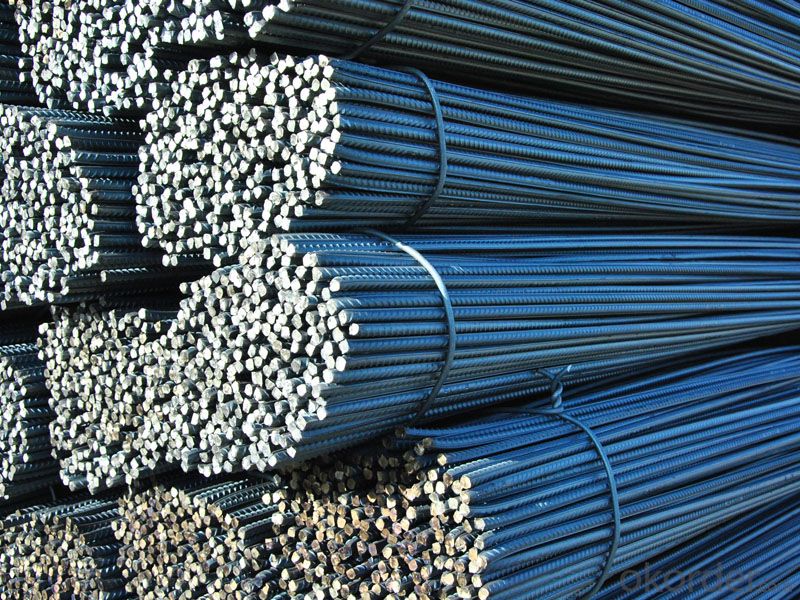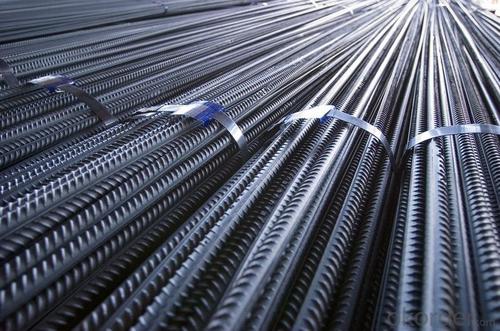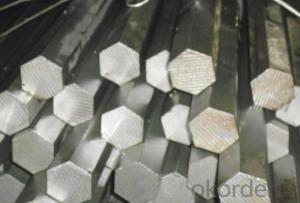Hot Rolled Deformed bar with Good Quality
- Loading Port:
- Tianjin
- Payment Terms:
- TT OR LC
- Min Order Qty:
- 25 m.t.
- Supply Capability:
- 10000 m.t./month
OKorder Service Pledge
OKorder Financial Service
You Might Also Like
OKorder is offering Deformed Steel Bar with high quality at great prices with worldwide shipping. Our supplier is a world-class manufacturer of steel, with our products utilized the world over. OKorder annually supplies products to European, North American and Asian markets. We provide quotations within 24 hours of receiving an inquiry and guarantee competitive prices.
Note:
1. Our products are produced according to national standard (GB), if not, supply according to national standards (GB) or agreement as customer required.
2. Other Grade and Standard Deformed Steel Bar we can supply:
Grade: GR40/GR60, G460B/B500A/B500B/B500C,BST500S
Standard: ASTM, BS, DIN
3. We can not only supply Deformed Steel Bar; if you need anything about building materials, please contact us for further information.
4. Please send us your detail specifications when inquire. We will reply to you as soon as possible. We sincerely hope we can establish a long stable business relationship.
Product Applications:
Deformed Steel Bar with high quality are ideal for structural applications and are widely used in the construction of buildings and bridges, and the manufacturing, petrochemical, and transportation industries.
Product Advantages:
OKorder's Deformed Steel Bar with high quality are durable, strong, and resist corrosion.
Main Product Features:
· Premium quality
· Prompt delivery & seaworthy packing (30 days after receiving deposit)
· Corrosion resistance
· Can be recycled and reused
· Mill test certification
Product Specifications:
Standard | GB | HRB400 | |
Diameter | 10mm-32mm | ||
Length | 6M, 12M | ||
Place of origin | Hebei, China mainland | ||
Advantages | exact size, regular package, chemical and mechanical properties are stable. | ||
Type | Hot rolled deformed steel bar | ||
Chemical Composition:
Grade | Technical data of the original chemical composition (%) | ||||||
C | Mn | Si | S | P | V | ||
HRB400 | ≤0.25 | ≤1.60 | ≤0.80 | ≤0.045 | ≤0.045 | 0.04-0.12 | |
Physical capability | |||||||
Yield Strength (N/cm²) | Tensile Strength (N/cm²) | Elongation (%) | |||||
≥400 | ≥570 | ≥14 | |||||
Theoretical weight and section area of each diameter as below for your information:
Diameter(mm) | Section area (mm²) | Mass(kg/m) | Weight of 12m bar(kg) |
18 | 254.5 | 2.00 | 24 |
20 | 314.2 | 2.47 | 29.64 |
22 | 380.1 | 2.98 | 35.76 |
FAQ:
Q1: Why buy Materials & Equipment from OKorder.com?
A1: All products offered byOKorder.com are carefully selected from China's most reliable manufacturing enterprises. Through its ISO certifications, OKorder.com adheres to the highest standards and a commitment to supply chain safety and customer satisfaction.
Q2: How do you guarantee the quality of our products?
A2: We have established an advanced quality management system which conducts strict quality tests at every step, from raw materials to the final product. At the same time, we provide extensive follow-up service assurances as required.
Q3: How soon can we receive the product after purchase?
A3: Within three days of placing an order, we will begin production. The specific shipping date is dependent upon international and government factors, but is typically 7 to 10 workdays.
bdenum enhance this surface layer and improve the corrosion resistance of the stainless material.
Images:


- Q: Can steel rebars be used in structures exposed to extreme temperatures?
- Yes, steel rebars can be used in structures exposed to extreme temperatures. Steel has high thermal conductivity, which allows it to transfer heat quickly, minimizing the risk of structural damage due to thermal expansion or contraction. However, it is essential to consider the specific temperature range and the potential impact on the structural integrity of the rebar. In extremely high temperatures, other materials or protective measures may be necessary to ensure the stability and safety of the structure.
- Q: Which is more expensive, rebar or round steel? Which is your business opportunity, such as thread steel and round bar?
- The two thread steel and round steel, which will be more expensive, steel and round steel prices now are soaring, steel prices per ton in 4300 yuan / ton, quality steel grade three Beijing qianshengcheng price is in 3950-4200 yuan / ton.
- Q: Are steel rebars resistant to fire?
- Yes, steel rebars are highly resistant to fire. The high melting point of steel makes rebars withstand extreme temperatures and maintain their structural integrity during a fire. Additionally, the presence of steel rebars in concrete structures can help prevent spalling, which is the breaking off of concrete due to high heat exposure.
- Q: Are steel rebars prone to bending or warping?
- Under normal conditions, steel rebars do not typically bend or warp. Their purpose in construction projects is to reinforce concrete structures, as they possess high tensile strength. These rebars are crafted from durable materials like carbon steel, enabling them to bear heavy loads without deforming. Nevertheless, it is crucial to acknowledge that external factors, such as excessive heat or improper handling during transportation and storage, can potentially cause rebars to bend or warp. Exposure to high temperatures compromises the structural integrity of steel rebars, rendering them more susceptible to deformation. Similarly, mishandling or inadequate storage practices, like uneven stacking or placing heavy objects on top, can result in deformation. To guarantee the structural integrity of steel rebars, it is vital to adhere to proper handling and storage guidelines, while also ensuring they are utilized within specified load limits. Moreover, considering the environmental conditions in which the rebars will be employed is essential for minimizing the risk of bending or warping.
- Q: How do steel rebars affect the overall workability of concrete?
- Concrete's overall workability is significantly improved by steel rebars. Workability refers to how easily concrete can be mixed, placed, compacted, and finished to achieve the desired shape and surface. The incorporation of steel rebars into concrete provides reinforcement and enhances its structural strength. These rebars act as a skeleton within the concrete matrix and evenly distribute loads and stresses throughout the structure. This reinforcement prevents cracking, improves structural integrity, and increases the concrete's load-bearing capacity. Steel rebars also aid in controlling shrinkage and cracking in concrete. During the curing process, concrete tends to shrink, leading to crack formation. However, the presence of rebars counteracts the tensile forces causing shrinkage and cracking, thus enhancing the concrete's overall durability. In addition to their structural benefits, steel rebars also facilitate concrete workability during construction. They guide proper concrete placement and prevent mix segregation or separation. These rebars ensure proper compaction, eliminating potential voids or air pockets and resulting in a more uniform mixture. Furthermore, steel rebars provide stability and support to concrete during curing and hardening stages. They prevent deformation or sagging of fresh concrete, ensuring it maintains its desired shape and form. This is particularly crucial for complex or intricate structures requiring precise shaping and positioning. Overall, the inclusion of steel rebars positively impacts concrete workability by enhancing structural strength, mitigating shrinkage and cracking, facilitating proper placement and compaction, and providing stability during the curing process. The combination of concrete and steel rebars creates a durable and reliable construction material capable of withstanding various loads and environmental conditions.
- Q: Can steel rebars be used in precast or prestressed concrete?
- Yes, steel rebars can be used in both precast and prestressed concrete. Rebars are commonly used in these construction methods to provide reinforcement and enhance the strength and durability of the concrete structures.
- Q: Can steel rebars be used in precast concrete applications?
- Precast concrete applications can make use of steel rebars. When referring to precast concrete, it means the process of casting concrete elements like walls, slabs, or beams in a controlled environment before transporting them to the construction site for installation. Steel rebars, which are typically made of carbon steel and have ribs on their surface to enhance adhesion to the concrete, are commonly utilized to reinforce precast concrete elements. The utilization of steel rebars in precast concrete applications comes with several advantages. Firstly, the presence of rebars increases the overall strength and durability of the precast concrete elements, enabling them to handle higher loads and reducing the risk of structural failure. Additionally, rebars enhance the resistance of precast elements to cracking and shrinkage, thereby ensuring better long-term performance. Furthermore, steel rebars facilitate the efficient transfer of tensile forces within precast concrete elements. While concrete exhibits excellent compressive strength, it is relatively weak in tension. By incorporating rebars into precast elements, the tensile forces generated during service can be effectively absorbed by the rebars, preventing cracks and maintaining the structural integrity of the element. Moreover, steel rebars offer flexibility in design and construction. Precast concrete elements can be manufactured in a wide range of shapes and sizes to meet specific project requirements, and the inclusion of rebars allows for greater design freedom. This enables the creation of complex and intricate precast elements that can be customized to suit various architectural and structural designs. In conclusion, steel rebars are crucial components in precast concrete applications. Their inclusion significantly enhances the strength, durability, and performance of precast concrete elements. By resisting tensile forces and providing structural integrity, steel rebars play a vital role in ensuring the safety and longevity of precast concrete structures.
- Q: What's the difference between round bar and screw steel? Which one is cheaper on the market at present?
- Round bar is divided into three parts: hot rolling, forging and cold drawing. Standard Specification for hot rolled round steel is 5.5-250 mm. Of which: 5.5-25 mm of small round bars, commonly used as steel, bolts and various mechanical parts, larger than 25 millimeters of round steel, mainly for the manufacture of machinery parts. Round steel has many kinds of materials, such as: Q195, Q235, 10#, 20#, 35#, 45#, Q215, Q235, 304, 316, 20Cr, 40Cr, 20CrMo, 35CrMo, 20CrMnTi, 5CrMnMo, etc...
- Q: How do steel rebars resist shear forces in concrete structures?
- Steel rebars resist shear forces in concrete structures by providing additional strength and reinforcement. The rebars are embedded within the concrete, creating a composite material that can withstand shear stresses. The steel rebars help to distribute the shear forces evenly throughout the structure, preventing cracks and failure. Additionally, the high tensile strength of the steel rebars allows them to resist deformation and displacement under shear loads, ensuring the stability and integrity of the concrete structure.
- Q: How do steel rebars affect the overall cost of a construction project?
- Steel rebars can significantly impact the overall cost of a construction project. These reinforcement bars are vital for providing structural strength and stability to concrete structures. The cost of steel rebars depends on factors such as quantity, quality, and market prices. As rebars are typically priced per ton, the more reinforcement required, the higher the cost. Moreover, fluctuations in steel prices can affect overall project expenses. However, the investment in steel rebars is crucial to ensure the durability and safety of the construction, making it a necessary expense in most projects.
Send your message to us
Hot Rolled Deformed bar with Good Quality
- Loading Port:
- Tianjin
- Payment Terms:
- TT OR LC
- Min Order Qty:
- 25 m.t.
- Supply Capability:
- 10000 m.t./month
OKorder Service Pledge
OKorder Financial Service
Similar products
Hot products
Hot Searches
Related keywords



























